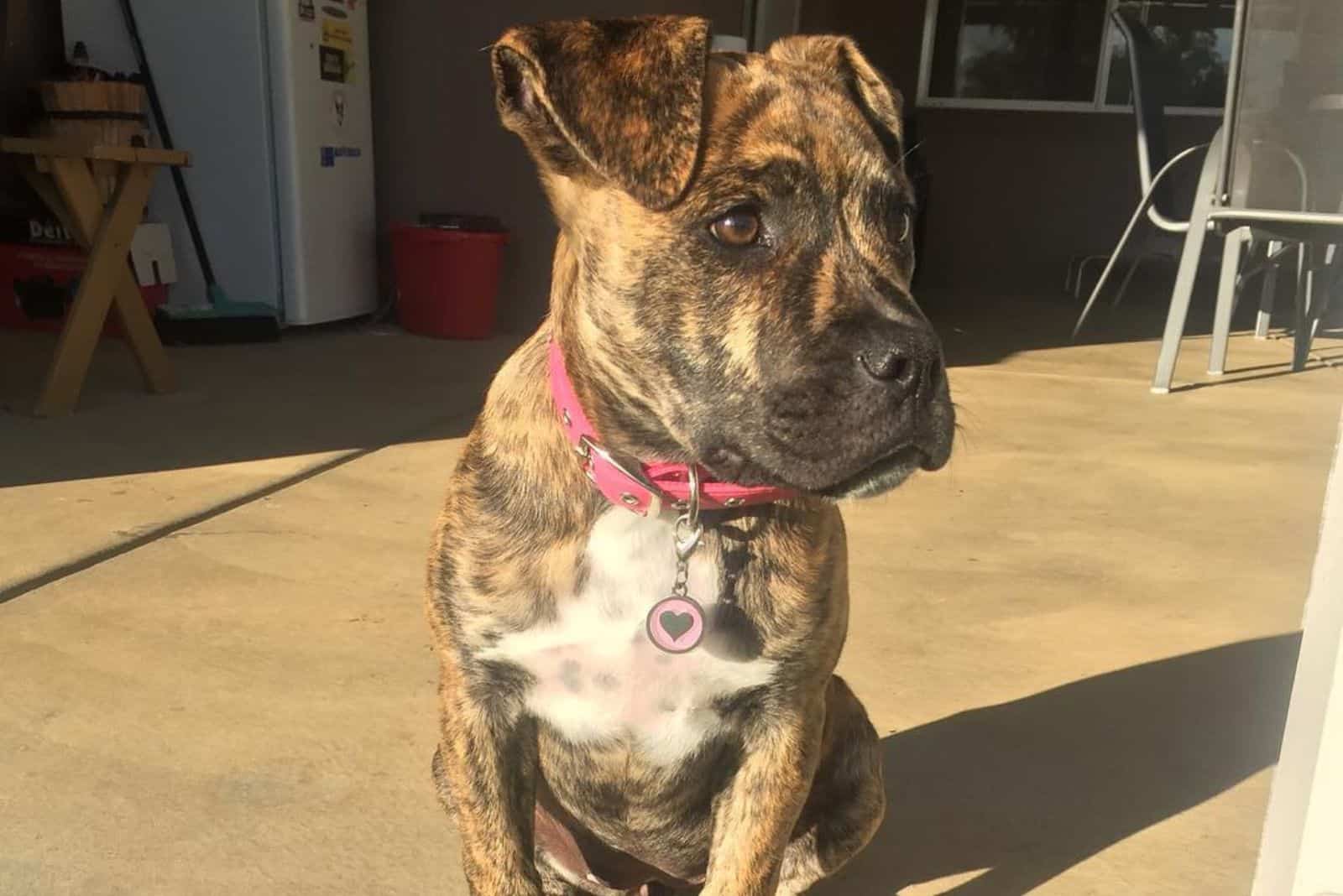The Great Dane Bullmastiff mix is a designer dog that has become somewhat more popular in the last decade even though it is a relatively recent breed.
Bull Daniffs, which are the offspring of two enormous working breeds, are not your typical hybrids. However, as long as the home has enough room for their enormous bodies, these huge canines can be wonderful family pets.
They are well-known for forming close relationships with their families and being hesitant around outsiders, making them the perfect choice for households searching for a dog who can serve as both a family pet and a protector.
Bull Daniffs have a fun side that can make anyone laugh, despite the fact that many people may find them to be serious.
What Is The Great Dane Bullmastiff Mix
The Great Dane Bullmastiff Mix breed provides a dog with the fun and energetic nature of the world’s largest lapdog, the legendary Great Dane, and the kind and unflappable temperament of the Bullmastiff.
It is one of the many beloved Great Dane mixes available!
The Bull Daniff is a devoted and affectionate friend who prefers a big house with a safe outdoor area to run around in. The hybrid, according to his owners, is gentle but performs best when handled firmly and consistently.
But with any mixed breed, it’s crucial to learn about the parent breeds’ physical characteristics and personalities. This is due to the fact that it is impossible to anticipate with absolute certainty which traits would predominate in any certain dog.
Let’s Meet The Parents
It is crucial to have an understanding of a breed’s origins and development in order to fully appreciate its traits and personality.
That is particularly the case with designer dogs, and mixed breeds in general, as their characters will usually be predicated on the personalities of their parent breeds.
So, with that in mind, probably the best way to start explaining what the Great Dane Bullmastiff mix is all about, is by talking about its closest ancestors — the Great Dane and the Bullmastiff.
The intriguing history of the Great Dane and Bullmastiff is detailed in the paragraphs that follow.
The Great Dane
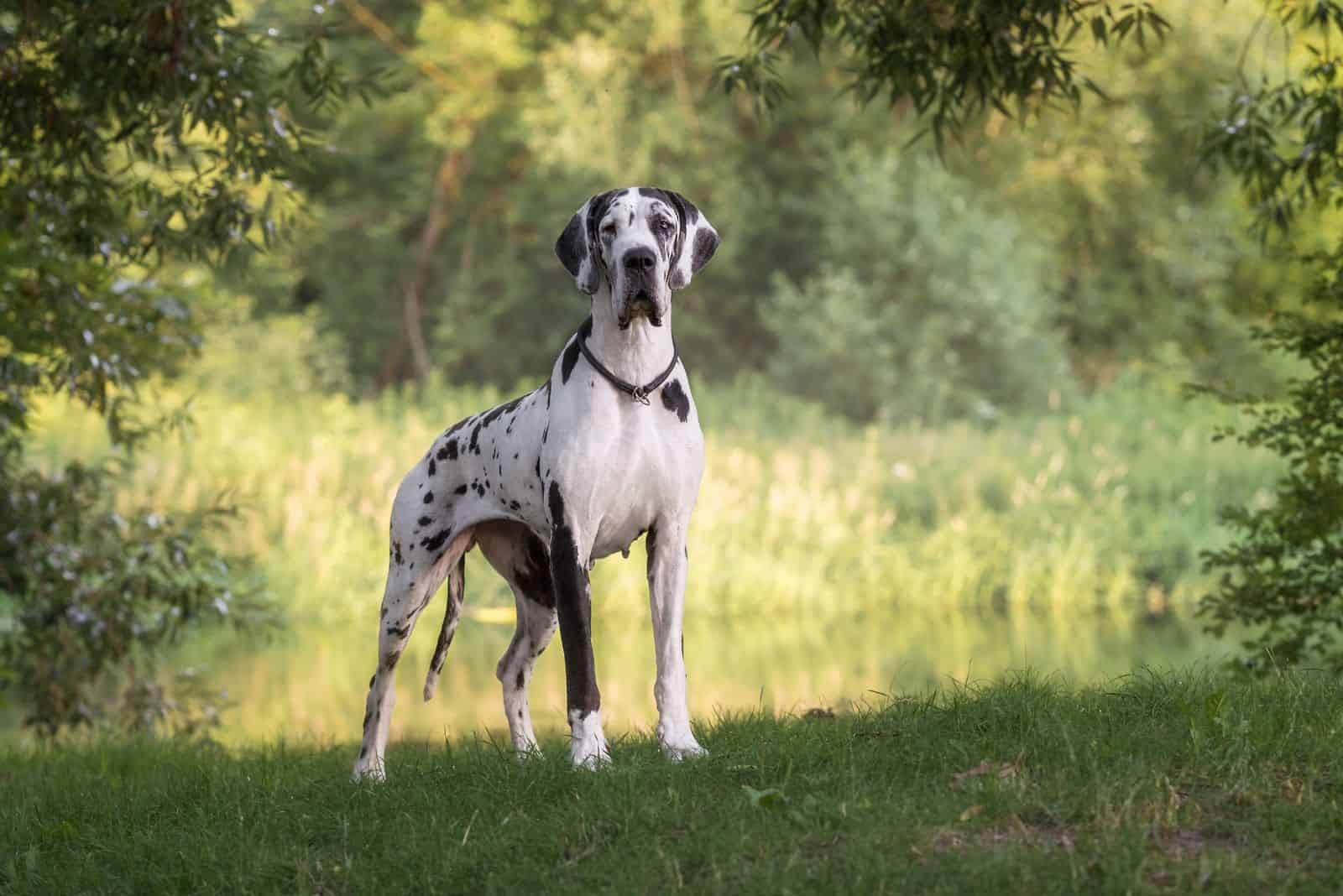
Great Danes are one of those dog breeds that have a certain proud, almost royal, reputation. They are beloved and respected by a lot of people, and it’s not hard to see why.
The American Kennel Club (AKC) registration figures place the Great Dane as the 15th most popular breed at the moment, and that ranking has been fairly steady for a long time.
That’s really impressive, especially when you consider how much special attention giant dogs require.
As you might have suspected, this dog breed has a very long and fascinating history. So let’s break it down through some of the most interesting facets.
Origins Of The Great Dane
National claims to possession of this enormous hound have historically been a major source of controversy, which may be a reflection of its eminent magisterial nature.
Although some theories claim Scandinavian origins even earlier, most authorities concur that this breed originated in Germany. That’s why the breed is occasionally known as the German Mastiff or the German Boarhound.
It was an extremely highly valued dog back then, and it certainly is now, at least according to its price tag.
There is even some proof that this type of dog existed in Ancient Greece, and there are even images of dogs that resemble the wonderful breed that we have now in Ancient Egyptian tombs from 3000 BC.
There are more detailed written and visual records of the ancestors of this enormous breed dating from the 13th and 14th centuries. They were referred to as the English Dogge in Germany because they were mostly based on the English Mastiff, which is a descendant of the huge and vicious Molussus dog.
A Hunting Dog For The Noblemen
Interbreeding with the Irish Wolfhound and perhaps other sight-hounds like the Greyhound is thought to have contributed to the extra size and speed of these dogs.
This preserved the strength and power that we still associate with the Great Dane while adding more of a lean, athletic frame.
Although they were catcher-dogs who ran alongside the horses, these enormous hounds did not have the job of sighting the prey. These dogs were sent in to bring down large, strong prey like wild boars, deer, and even bears once the prey had been located.
Even now, this amazing hound, which was formerly the companion of kings and noblemen, preserves a sense of being an aristocrat among dogs thanks to its magnificent power and speed as well as its regal appearance.
The Tallest Dog Ever
Although kennel associations maintain that for dogs produced to high standards, there is a total equivalence between American and European breed standards, some breeders assert that there is a discernible difference in appearance.
American Great Dane puppies are largely the same as European ones, but once they become adult dogs, they tend to be tighter around the face and have a little lighter frame than their European counterparts, who have more loose skin, larger lips, and squarer heads.
The largest dog ever measured was a Great Dane named Zeus from Michigan in the United States, who measured a stunning 44 inches (about 119 cm) from foot to withers.
The Irish Wolfhound is commonly acknowledged as the tallest breed on average, though.
The Bullmastiff
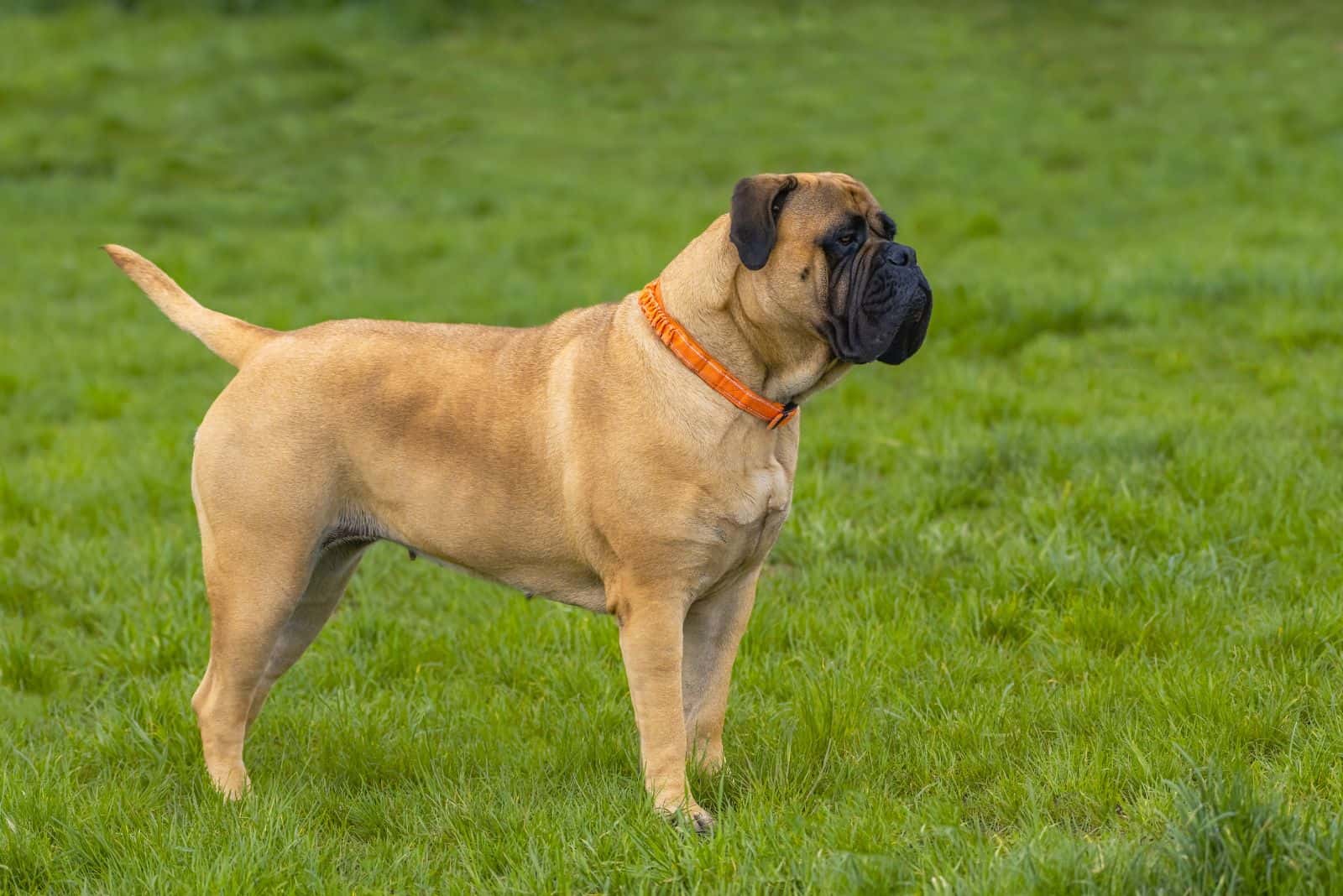
The Bullmastiff dog breed makes an unflinching and forceful family protector. While reserved towards outsiders, they have compassion for their loved ones.
Despite being so large and imposing, they are often known as the silent watchdog, and they make surprisingly excellent apartment dogs.
Additionally, much like their Great Dane counterparts, Bullmastiffs have a long and rich history, as well. So let’s delve into it together.
Origins Of The Bullmastiff
The English Mastiff and English Bulldog were crossed by English breeders in the later part of the nineteenth century in an effort to create the ideal guard dog.
These early Bullmastiffs patrolled the gentry’s grounds with gamekeepers to catch and prevent poachers. They were fearsome, but calm dogs who matched moderate activity levels with a high appetite.
There was more going on here than a simple game of cat and mouse in the English countryside. Poaching carried harsh legal repercussions, and if you were caught, you may be executed.
Some of them would even have their own dogs with them, which they could use to attack the gamekeepers and make their escape. Because of this, the Bullmastiff earned the nickname “gamekeeper’s night dog” and became the canine of choice for chasing away poachers and their dogs.
The Gamekeeper’s Night Dog
The Bullmastiff was created by crossing early hunting and fighting breeds, giving it the bravery and fearlessness of the pugnacious Bulldog with all the single-minded resolve of the English Mastiff.
According to canine specialists, the Bullmastiff is roughly 60% Mastiff and 40% Bulldog, resulting in a large dog that might tackle and subdue an intruder.
This dog was not quick enough to hunt down poachers, but the Mastiff had been excellent at locating and holding large game. The Bulldog did not have the size to easily bring down a human and was too naturally violent to just hold or detain its prey.
This meant that in the pursuit of poachers, the English Bullmastiff provided the ideal balance of speed and restraint. Additionally, they inherited the Mastiff’s propensity to grip rather than savage their prey, which was ideal for apprehending a poacher and handing them over to the law’s less-than-merciful hands.
The gamekeeper’s Bullmastiff served admirably as a family protector and security dog during the day. Ironically, it was this breed’s secondary function as a devoted and gentle family protector that ultimately saved them and continues to draw owners to them today.
Not only did it find a new lease on life as a family companion and protector, but it also became very valuable and pricey, due to its many qualities.
A Loving Family Companion
However, with the repeal of the anti-poaching laws, this breed’s primary function was lost, and the number of Bullmastiffs drastically decreased. However, it was their function as loving and obedient family dogs that ensured the survival of this wonderful breed.
The Bullmastiff Club was established in the 1920s by a group of enthusiasts who saw the breed’s potential as a guard dog in the future. The English Kennel Club standardized and recognized the breed in 1924.
As this magnificent species gained popularity in the USA across the pond, the AKC quickly followed suit and recognized them as a breed in 1934.
The fact that this stunning breed of dog currently holds the 55th spot in the AKC popularity rankings on registration data is a fitting testament to their enduring appeal.
The Origin Of The Great Dane Bullmastiff Mix
It would be fair to say that the Bull Daniff’s origin story has not yet been written. This designer breed, which the International Designer Canine Registry approved in 2009, is thought to have its roots in the United States.
Since the Great Dane Bullmastiff mix is a relatively recent first-generation crossbreed, there isn’t much history to go off.
As more time passes, this hybrid becomes more common, and second and third generations start popping up, we will have a clearer image of this dog’s true identity.
As of now, we can only go off its parent breeds, which is why we presented their history in so much detail. If the temperaments of the Bullmastiff and the Great Dane are anything to go by, this mix will continue to be an imposing, but loving, watchdog that devotes its life to its family.
Great Dane Bullmastiff Mix Appearance
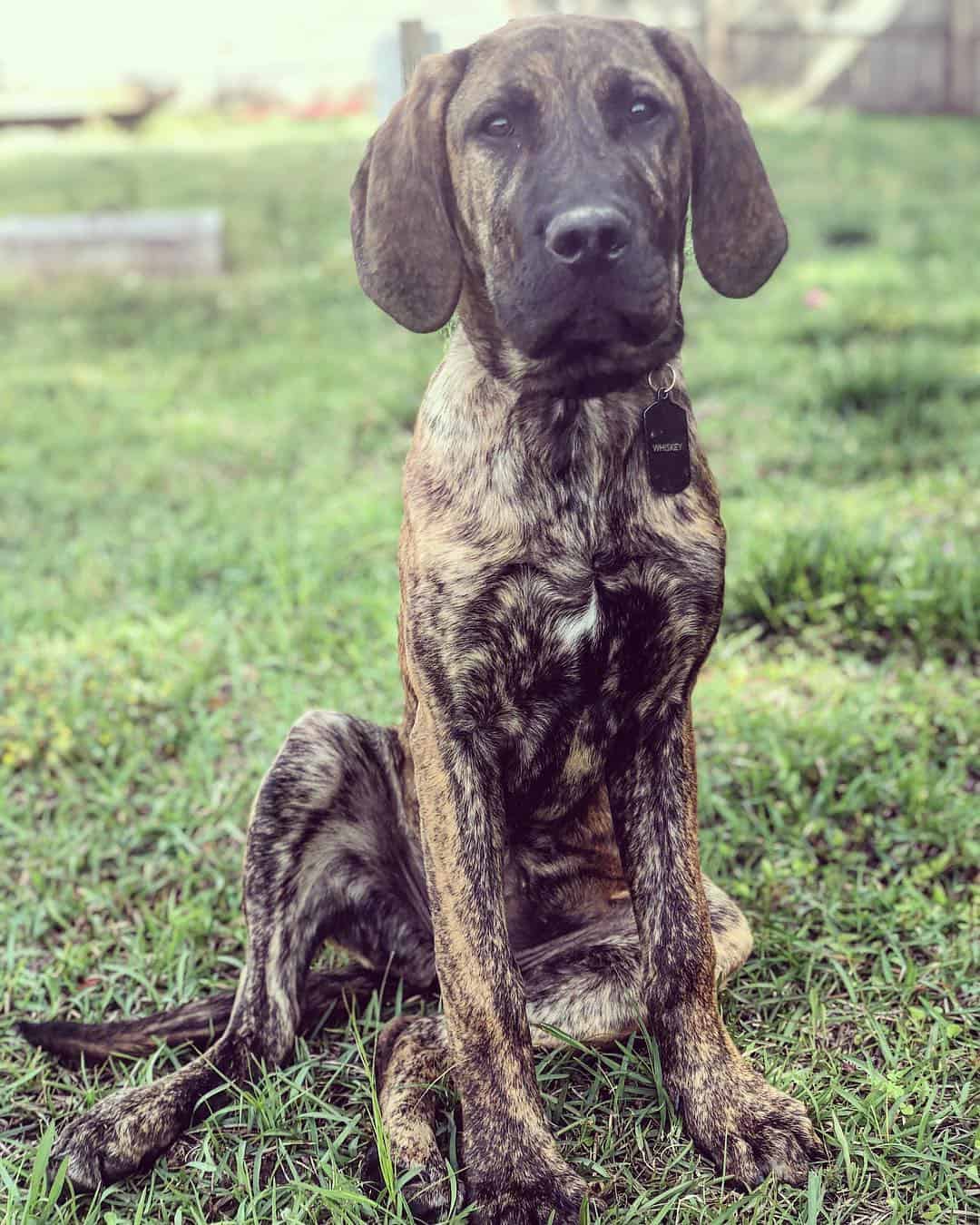
Since the Daniff dog breed is a crossbreed, a few of its traits will be up to chance.
In fact, you can tell that no two Great Dane Mastiff hybrid dogs are the same if you look at images of them.
So what common traits, besides the striking size that makes it a candidate for the tallest dog in the world, might this crossbreed have?
The muzzle of this hybrid breed is likely to be too large, and some of them may inherit the distinctive Bullmastiff wrinkles. Medium-sized eyes and floppy ears are most frequently present.
Due to its powerful and beautiful movement and robust hindquarters, this dog will have both stamina and a respectable amount of speed.
Bull Daniff Size
It should be mentioned that because Bull Daniffs are descendants of one giant breed and one large breed, they can easily weigh more than 150 pounds.
In fact, that is basically their average adult weight, and some of them can go way beyond that. Which is why it’s important to stress that you need to make sure you have enough room for these dogs if you’re considering purchasing this hybrid.
Although it may take this crossbreed two years to reach full maturity, expect your Bull Daniff to attain a size between 28 and 30 inches tall and weigh between 110 and 280 pounds. That is pretty, pretty, pretty big, you would agree.
And big dogs need a big name, so if you’re thinking about adopting one of these extra-large pooches, perhaps you can find some inspiration in our list of 100+ big dog names!
Bull Daniff Coat
The Bull Daniff is most frequently seen in black and white, light brown, gray, gold, and tan. Additionally, they could have spotted, merle, or brindle coats.
Aside from color patterns, there are some other coat characteristics that a lot of these dogs share. Their fur is typically short to medium in length, not particularly dense, and very short.
It is similar to the coats of many Mastiff variations, and just like a lot of those, it makes for pretty easy maintenance.
Great Dane Bullmastiff Mix Temperament
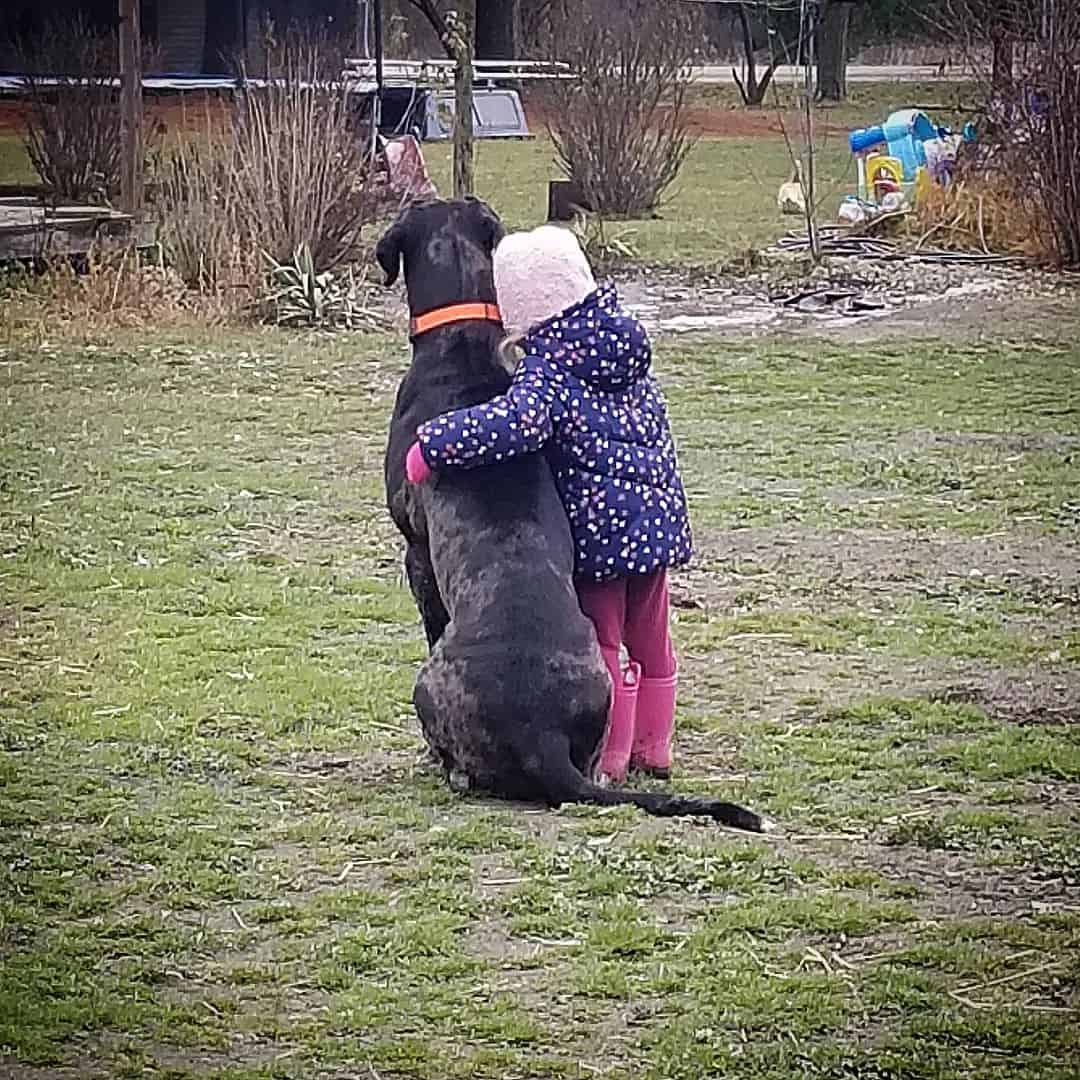
The Bull Daniff will exhibit both of his parents’ behavioral and psychological characteristics. There may be differences in temperament even among littermates. However, as a whole, this mix is extremely bright, self-assured, and dependable.
Early socialization of your Great Dane Bullmastiff mix puppy is very crucial. Although they are rarely hostile, strangers might make the Bull Daniff wary. It will be watchful and protective thanks to the features of both the Bullmastiff and Great Dane.
Bullmastiffs are powerful guard dogs with calm, restrained personalities and excellent senses. Bullmastiffs can be boisterous as puppies, but as they become older, they become more subdued and serious dogs.
These large dogs are loving and affectionate couch potatoes who enjoy spending time with their families. However, they require a strong, dominant leader to avoid stubbornness and other behavioral problems.
Great Danes are regarded as having calm dispositions and are frequently referred to as gentle giants due to their demeanor. These enormous dogs make ideal family pets because they are affectionate and playful.
Although Great Danes have a natural inclination to protect the home, they do so without becoming hostile. Danes are intelligent and fast to pick up on obedience, but if pushed too far, they can develop stubbornness.
But let’s now get back to the Great Dane Bullmastiff mix and try to answer some of the most important questions related to their temperament, behavior, and adaptability.
Are They Good Family Dogs?
Bull Daniffs are actually quite docile, unlike several medium- and large-sized dog breeds that have trouble understanding their own strength. Due to their reserved demeanor, these hybrids and their purebred parents make great family pets for children of all ages.
Given the characteristics of both Great Danes and Bullmastiffs, it is reasonable to say that the majority of Great Dane Bullmastiff Mixes will become loving family pets.
In fact, Mastiffs in general, as this article conveys, are great for families for various reasons.
Are They Good Around Kids?
Bull Daniffs have a playful side that makes them perfect for families with kids despite their enormous size and stern features. Bull Daniffs love observing from a distance to supervise the children even if they don’t require hours of exercise.
The only potential problem is that they might start to overprotect kids, especially when there are strangers around.
In short, children are loved by the Bull Daniff. However, they still need to be watched when playing with young kids because of their size.
Are They Good Around Other Pets?
The majority of Bull Daniffs share the reputation of Great Danes and Mastiff breeds for having weak prey drives. Your new Bull Daniff puppy will get along with its new brothers and sisters reasonably fast as long as all pets are properly introduced.
However, early socialization will be needed in order to make sure that this large hound can play with its canine friends without any problems.
This makes this magnificent hybrid breed ideally suitable for a home with multiple dogs, though you should be careful when bringing a puppy to an older dog.
Are They Easy To Train?
The Bullmastiff is known for being a little stubborn, whereas the Great Dane is bright and sociable. But the urge to please their owners is innate in both kinds.
This indicates that the mixed-breed dog will respond favorably to regular training and be controllable both inside and outside the house.
These dogs are generally quiet and well-behaved, but they require a strong leader to handle any potential behavioral issues. They might start off as energetic pups, but they will eventually calm down.
Early socialization is crucial to establishing appropriate limits with other people and animals, just like it is with other canines.
Are They Good For First-Time Dog Owners?
Although Bull Daniffs are renowned for being loyal and devoted guard dogs, they can be difficult for novice dog owners due to their intransigence. To prevent them from taking over the household, early, persistent, and assured instruction is required.
Additionally, they are known to be very attached to their owners, so they will require a lot of your attention. You shouldn’t leave them alone for long periods of time, especially during their puppyhood, because they might suffer from separation anxiety.
Great Dane Bullmastiff Mix Diet
Due to their propensity for weight issues and obesity, Bull Daniffs should consume a diet rich in fiber. A high-quality dry kibble designed for large breeds is what we advise, but it’s critical that there be adequate fiber to support digestion.
Typically, they tend to have nutritional needs similar to those of their parents, so you can’t go too wrong with serving it dog food that a Great Dane would like, for example.
The recommended daily intake for Bull Daniffs is around four cups of kibble, but that amount is not representative of every single dog. As we already mentioned, Daniffs can vary wildly in terms of their size, and that is something that will have a big impact on their nutritional needs.
Obviously, you won’t feed the same amount of dog food to a 120-pound dog and a 200-pound dog.
In any case, it’s always a good idea to speak with your veterinarian before beginning any new diet or choosing a dog food brand.
Great Dane Bullmastiff Mix Physical Activity
Bullmastiffs and Great Danes are both noted for having reduced exercise needs, but that doesn’t mean that they should just sit around and lounge on your couch all day long.
They’ll require at least two long walks each day, as well as some unsupervised, off-leash, free time.
They will like running around on their own in a fenced-in yard and playing fetch as well. Additionally, they might like going to a dog park, and it’s a good idea to get them acclimated to interacting with strangers.
Just bear in mind that the amount of playtime should be restricted in hot weather since their size can lead them to overheat.
During their puppyhood, his energy levels will be higher, but because it is a large breed and growing quickly, it is important for it to avoid overdoing activities that could strain his bones and joints.
Their skeleton is still growing and developing, so be careful and avoid over-exerting them.
Great Dane Bullmastiff Mix Training
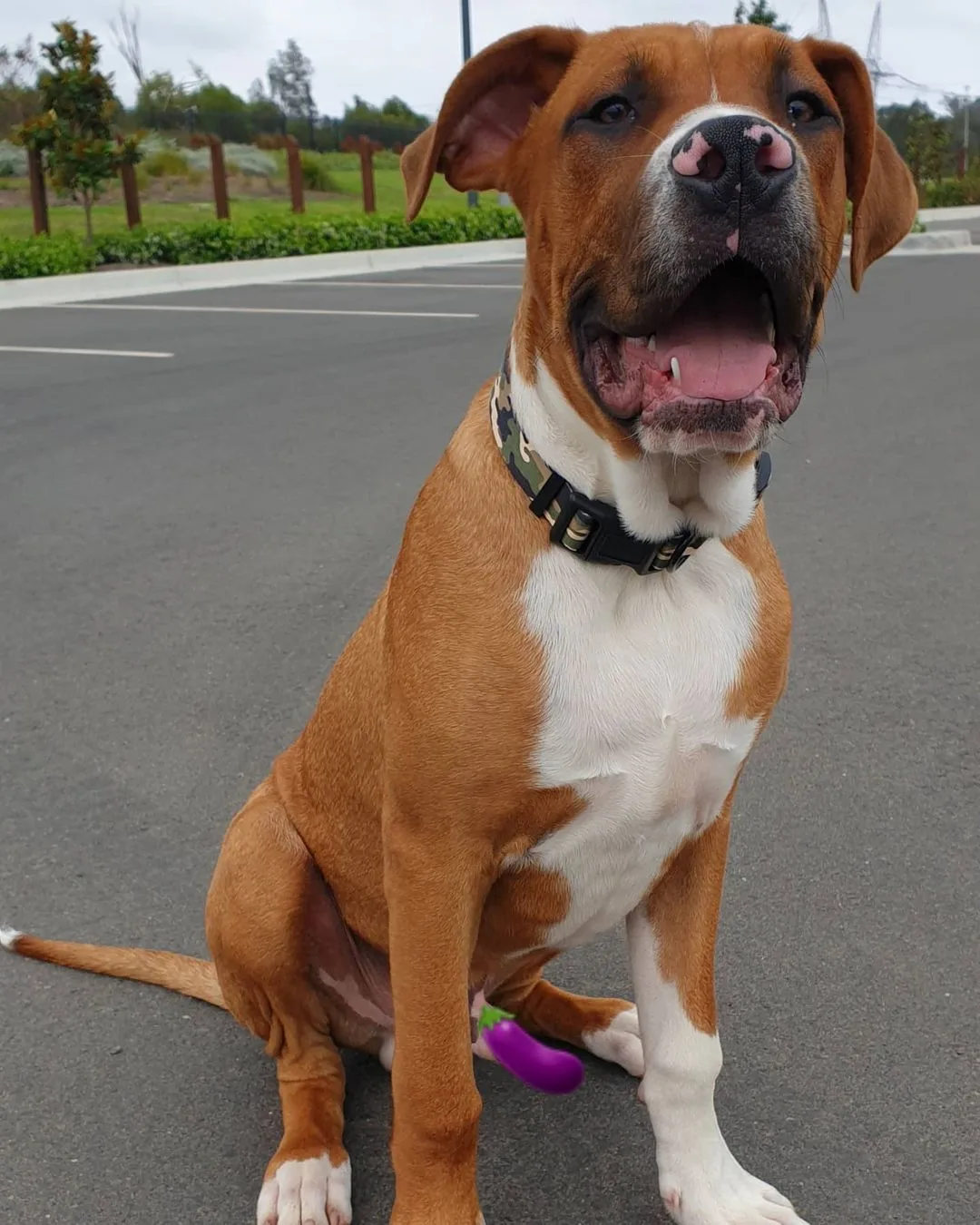
Bull Daniffs flourish when their leader is self-assured and they receive positive reinforcement through food and praise, especially when the Daniffs are more Bullmastiff-like.
Being gentle and persistent with any training methods is essential since these dogs are sensitive and will resist commands if they feel they are being teased.
If left unchecked, a Great Dane Bullmastiff Mix‘s stubbornness can become a serious problem, but teaching these large dogs successfully requires persistence and patience.
Consider enrolling your Great Dane or Bullmastiff in group-based puppy obedience classes because both breeds require early socialization and persistent training.
This gives your new puppy the opportunity to socialize with other dogs in addition to teaching you and your dog the fundamentals. It can also take some of the dog training responsibility off your hands and save you time.
Great Dane Bullmastiff Mix Grooming
Bull Daniffs have short, mildly shedding coats that require very little upkeep. Therefore a thorough brushing once a week should be enough to handle the shedding.
We advise using a curry comb to massage the skin and coat while also removing dirt and matted fur. Otherwise, they have coats that don’t require hours of combing.
In fact, we have a great article about the best brushes for Great Danes, and since they have very similar coats, a lot of the stuff we talk about in that also applies here.
Danes and Bullmastiffs both have delicate skin, therefore it’s crucial to avoid bathing them too frequently. After a bath or a stroll in the rain, they need to be completely and delicately dried off.
To avoid a bacterial or yeast infection on his skin, the folds on their body should be washed and kept dry. Their ears should be examined frequently, and if dirt and debris are found, they should be cleaned using an ear wash.
Furthermore, their teeth should be brushed with dog toothpaste several times per week to avoid tartar buildup and gingivitis.
They also might require a monthly trimming of the nails. During puppyhood, it is advised to regularly trim their nails to help them get used to the procedure and make it easier for you in the future. Some dogs never really get used to it and might even need sedating.
Great Dane Bullmastiff Mix Health
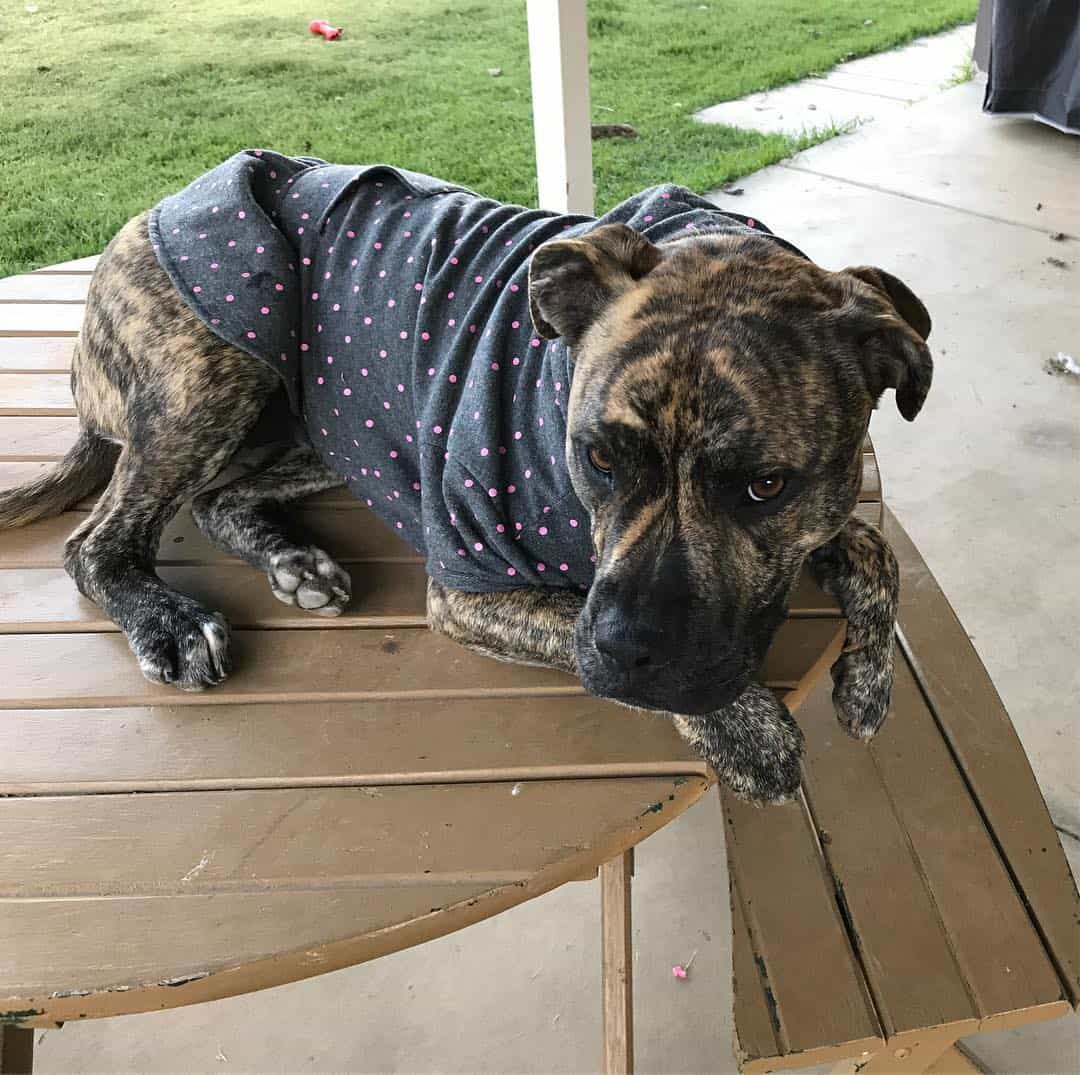
Even with purebred dogs, it’s impossible to predict exactly what health problems might arise during their life. It’s even more complicated with mixed-breed dogs, since you have to take into account the health histories of two different breeds.
However, examining your puppy’s parents’ health problems and the health issues of other dogs in the same bloodline from their lineages will help you understand what you might be dealing with.
Learning about the common health conditions shared by the Great Dane and the Bullmastiff is another way to get ready, though there is no assurance that your puppy will carry any of these conditions.
Read next: The 22 Healthiest Dog Breeds – Dogs Who Live Long And Prosper
Common Health Issues In Great Dane Bullmastiff Mix Dogs
Both parent breeds are prone to certain diseases including hip and elbow dysplasia and bloat, especially given their size.
Aside from hypothyroidism, your Bull Daniff may also inherit a variety of skin and eye issues from both breeds. There is no way to determine whether your puppy has inherited any of these ailments, even though the majority of them are mildly serious.
Here is some more info about those conditions, just so you can have a basic idea of what to expect.
Hip Dysplasia
Dogs who have hip dysplasia do so when they are still growing. It causes the hip joint to loosen, which leads to dysfunction and discomfort.
The hip’s bone and cartilage start to deteriorate as the dog grows. This eventually results in arthritis, muscular atrophy, and decreased mobility.
Large-breed dogs, such as Great Danes and Bullmastiffs, but also breeds like the German Shepherd, Doberman, and Rottweiler, are more frequently affected, and research indicates that it is inherited.
Bloat
If untreated, gastric dilatation-volvulus (GDV) is a dangerous disorder that can be fatal. GDV, also known as bloat, is when a dog’s stomach fills with gas, food, or fluid and twists as a result. GDV can proceed swiftly and without prior notice.
Although it can happen at any age, middle-aged dogs tend to experience bloat the most. According to research, stomach dilatation has been documented in almost all breeds, however, it is more frequently observed in large-breed dogs with deep chests.
Smaller breeds, such as Pitbulls, aren’t entirely safe from it, either.
Hypothyroidism
Hypothyroidism in dogs is typically brought on by either idiopathic thyroid gland atrophy or lymphocytic thyroiditis.
The former condition, which is assumed to be an immune-mediated condition, is the most frequent cause of hypothyroidism. This indicates that the thyroid gets attacked by the immune system once it determines that it is aberrant or foreign.
Although the cause of this is unknown, it is a heritable trait, which means that genetics is involved in this illness.
Wobblers Syndrome
Large and giant dog breeds are more likely to have the cervical spine condition known as wobbler syndrome.
These dogs’ spinal cords and spinal nerve roots are compressed, which might cause nervous system impairments and/or neck pain.
Doberman Pinschers account for around half of the instances of wobbler syndrome found in dogs, and the Weimaraner, Great Dane, Rottweiler, and Dalmatian are other breeds that are frequently afflicted.
Despite some breed preferences, any dog breed, even small dogs, may be impacted.
Cardiomyopathy
Canine dilated cardiomyopathy (DCM) causes the heart’s capacity to produce pressure to pump blood via the vascular system to be reduced.
Although there is some disagreement on the precise cause of canine DCM, a number of potential causes, including dietary, viral, and genetic predisposition, have been suggested.
Although it is likely that the disease’s etiology is multifactorial, the fact that canine DCM is more common in particular breeds raises the possibility that this condition has a heritable genetic component.
Great Dane Bullmastiff Mix Lifespan
Sadly, Great Danes only live 6 to 8 years on average. The Bullmastiff has a slightly longer average life expectancy, between 8 and 10 years.
A Great Dane Bullmastiff mix’s expected lifespan is considered to be the average of those two, so that would be between 7 and 10 years.
Conclusion
Despite being large dogs, Great Dane Bullmastiff mix dogs are devoted and caring family guardians.
These enormous hybrids thrive on continual love and affection, so families who spend plenty of time at home are best for them. It’s vital to keep in mind that these dogs can easily weigh more than 150 pounds, so they do want enough room to spread out.
Although some people find their size to be a significant turnoff, they don’t need as much activity as other breeds. The Great Dane Bullmastiff mix won’t let you down if you’re looking for a quiet, reserved guard dog that’s also kind and good around kids.
Read Next: Great Dane Doberman Mix: The Great Sphinx Of Germany
